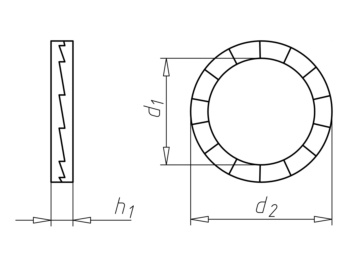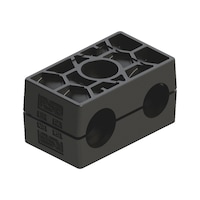Wedge lock washer Nord-Lock, narrow shape (NLss)
A4 stainless steel narrow shape NLss Nord-Lock
WSH-WDGELOK-NLSS-A4-3/8
Art.-no. 4639830037
EAN 4099618570124

Register now and access more than 125,000 products
General:
Original Nord-Lock wedge lock washers secure screw connections that are subject to severe vibrations and dynamic loads.
Function:
Highly secure locking as wedge surfaces slope up between the two lock washers. The screw connection is locked by pretension instead of by friction.
Advantages:
- Quick and easy installation/removal using standard tools
- Secure locking even with lubrication
- High corrosion resistance
- Reliable securing - even for screw connections with short clamp lengths
- Reusable (depending on operating environment)
- CE marking
- Laser marking for full traceability
- Designed for screws up to and including strength class 12.9 (steel) and A4-80 (high-grade steel)
Certificates and approvals:
- DIBt (Deutsches Institut für Bautechnik - German Institute for Construction Technology)
- DNV GL (Det Norske Veritas Germanischer Lloyd)
- EBA (Eisenbahn-Bundesamt - German Federal Railway Authority)
- TÜV (Technischer Überwachungs-Verein - German Technical Inspection Association)
- LR (Lloyd's Register)
Note:
For the recommended tightening torques, please see the technical information from the manufacturer.
Wedge lock washers made of surface-hardened stainless steel 1.4404 are not suitable for use in corrosive environments. For corresponding applications, we recommend the use of 254SMO (1.4547) stainless steel wedge lock washers.
Datasheets(X)
Vehicle manufacturing, mechanical engineering, manufacturers of pneumatic and power tools, mining, agricultural machine manufacturing, manufacturers of mixing systems, transport and conveyor systems.
 | |
Internal diameter (d1) | 10.3 mm |
Suitable for thread (imperial) | 3/8 inch |
Outer diameter (d2) | 16.6 mm |
Thickness (h1) | 2.0 mm |
Material | Stainless steel A4 |
Surface | Plain |
RoHS-compliant | Yes |
Design | Narrow |
Locking function | Locking against self-loosening by mechanical interlocking |



















